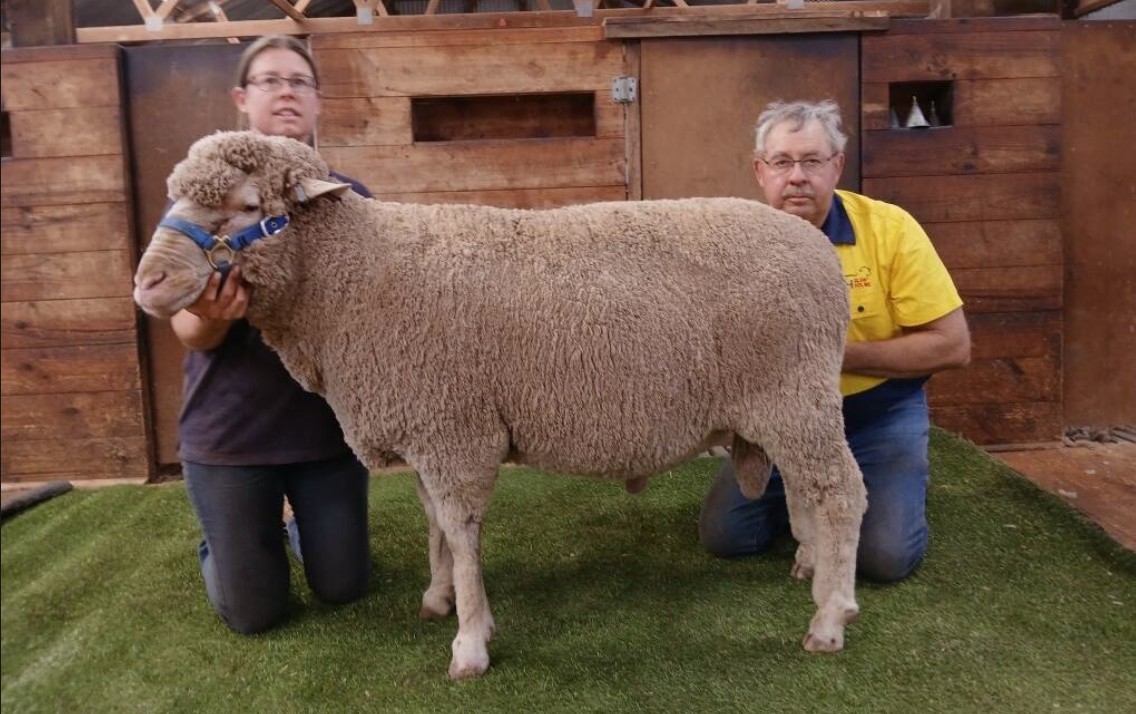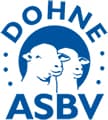SA Dohne performs well in national Merino index
Article courtesy of ACM (Alisha Fogden) Stock Journal

Glen Holme’s Lauren Philp and Allen Kelly with top performing ram Glen Holme 206139. Picture supplied
In their 20th year of breeding Dohnes, the Kelly family of Glen Holme stud at Manoora were recently surprised with a career achievement – one of their rams topped a Merino Superior Sires index.
The number one spot was in the Merino Lamb category in both the five-year update, ahead of 392 sires, and the all-time top 50, ahead of 648 sires.
According to Sheep Genetics, the ML index is based on a production system where the majority of income is from sheepmeat production, particularly lambs, with some income from adult ewe wool clips.
The index also focuses on genetic improvement of fleece weight, growth, lean meat yield, eating quality and reproduction, while reduced wrinkle is also included.
Among Glen Holme 206139’s figures on the five-year Merino Superior Sires update were a 0.4 yearling clean fleece weight, 5.3 adult CFW, 10.9 yearling weight and 2.3 yearling eye muscle depth, and was five points clear of the ram in second place.
Stud principal Allen Kelly, who has been breeding Dohnes since 2005, said the ram was a son of the 2019 Dohne national champion Glen Holme 172565 from the Australian Sheep & Wool Show at Bendigo, Vic.
“The bloodline goes back six generations to a Mount Alma ram, and has at least four generations of Glen Holme genetics down the sire line,” he said.
“206139 is a very deep bodied ram with an excellent rump, good quality wool, clear face and a kind eye.
“It also ranked at number six on the Sustainable Merino Index (SM) – the highest SA ram on that list – and seventh in the all-time top 50 for SM.”
According to Sheep Genetics, the SM index is based on a production system where the majority of income is from sheepmeat production, but there is still a large focus on wool clip and quality, including fleece weight, fibre diameter, and reproduction.
The index also focuses on reducing wrinkle, and increasing growth and lean meat yield.
“It’s akin to lining up 700 rams in front of a judge at a royal show and then coming out on top.”
Mr Kelly said the ram had been evaluated in trials at three different environments, at sites near Hamilton, Vic, Trangie, NSW, and in NSW’s New England region.
“To have risen to the top rank out of 648 of Australia’s best Merino sires over 34 years of evaluation, and to have three other rams in the top 50 ML index, is a huge achievement,” he said.
“In SM – that 206139 has placed at number six out of 34 years worth of evaluation and ahead of 704 rams.
“It’s akin to lining up 700 rams in front of a judge at a royal show and then coming out on top.
“In fairness this is the first year the adjusted indexes were implemented, with ML updated to include more reproduction and carcase characteristics, which obviously aligns well the Dohne and our breeding aims.”
Mr Kelly said they liked entering sires for evaluation because they felt that protected environments did not reveal how ram progeny coped with environmental pressures like high stocking rates, limited feed availability, heavy rainfall events, internal parasites etc.
“The only way to truly learn how the genetics from selected rams in your flock perform is for their progeny to be independently evaluated alongside the progeny of other sires in a commercial, large-scale setting, where each sheep’s identity is not known when measurements and assessments are being taken,” he said.
“We had one sire evaluated alongside 24 other rams, this meant that there was a very large group of ewes that were run in one mob for five years of productivity measurements. The data coming out of that project was enormously valuable.”
Mr Kelly said while the Merino Superior Sires results came out late last year, it had taken him a few months to “process the enormity of it”.
“We have had Dohnes perform well before, but this is the first year, we have got to number one, which is pretty amazing,” he said.
“Both the ML and SM traits are relevant to us in what we do, because we want healthy sheep with low maintenance requirements, who are very feed efficient, fertile and the Dohne is known for its longevity.
“We have weaning rates 30-40pc over the average, while coming out of a Poll Merino breeding background, we also have a strong focus on producing good quality wool.”
Mr Kelly hopes the stud’s achievement helps to change the perception of Dohnes
“Many in the Australian sheep industry have yet to recognise the value of the fertility and growth rate combination in Dohnes,” he said.
“Even our Dohne entry in among 132 sires in the Merino LIfetime Productivity Project was important – he did so well with reproduction. And while there was a loss in wool cut of roughly 900 grams a year, the excess 30-40pc weight at weaning overrode that when it came to total returns.”
Glen Holme has had seven Dohne rams under sire evaluation since 2015, with three now placed in the all-time top 50 – 162503, 172565 and 206139.
Two of the rams – 172565 and 206139 – are still working on-farm, with progeny of the latter coming on.
PERFORMANCE RECORDING PUSH
The Kelly family have bred Merinos through their Glen Holme stud for almost 80 years, aiming to produce commercially relevant sheep that have an optimal balance between growth, reproduction and wool quality.










 Facebook
Facebook YouTube
YouTube Instagram
Instagram